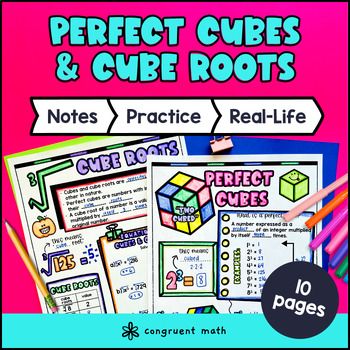Want more ideas and freebies?
Get my free resource library with digital & print activities—plus tips over email.
Join for Free Resources →
$4.25
Ever wondered how to teach cube roots and perfect cubes in an engaging way to your eighth-grade students?
In this lesson plan, students will learn about cube roots and perfect cubes and their real-life applications. Through artistic, interactive guided notes,a maze worksheet, and a color by code activity students will gain a comprehensive understanding of cube roots and perfect cubes.
The lesson culminates with a real-life example that explores how this math concept is applied to designing water tanks.

$4.25
After this lesson, students will be able to:
Before this lesson, students should be familiar with:
As a hook, ask students why understanding cube roots and perfect cubes is important in real life. Refer to the real-life application on the last page of the guided notes as well as the FAQs below for ideas.
Use the first page of the guided notes to introduce perfect cubes. Walk through the concept of perfect cubes and explain that a perfect cube is the result of multiplying a number by itself three times. Emphasize key points such as how to recognize perfect cubes and how to express perfect cubes using exponents. Refer to the FAQ below for ideas on how to respond to common student questions.
Use the second page of the guided notes to introduce cube roots. Explain that a cube root is the opposite operation of finding a perfect cube and is the number that, when multiplied by itself three times, equals a given value. Walk through the process of finding cube roots using the ∛ symbol and how to express cube roots using exponents. Refer to the FAQ below for ideas on how to respond to common student questions.
If your class has a wide range of proficiency levels, you can pull out students for reteaching, and have more advanced students begin work on the practice exercises.
Have students practice perfect cubes and cube roots using the practice maze activity provided in the resource. Walk around the classroom to answer any student questions and provide support as needed.
Fast finishers can dive into the color by code activity for extra practice. You can also assign these activities as homework for the remainder of the class.
Bring the class back together, and introduce the concept of designing cube-shaped water tanks as a real-world application of perfect cubes and cube roots. In this application, students will learn how to calculate the dimensions of a water tank based on its capacity.
Explain to the students that water tanks are commonly used to store and supply water in various settings, such as residential areas, farms, and industrial sites. The capacity of a water tank is measured in cubic units, which is where the concept of perfect cubes and cube roots becomes relevant.
Using the example of a cubic water tank, discuss with the students the formula for calculating the volume of a cube: V = x^3. Explain that in this formula, the side length (x) is the only dimension needed to determine its capacity.
Then guide a discussion on other places in everyday life that use perfect cubes in everyday life. Students can use the space in the guided notes to brainstorm their response first before sharing with the class.
Refer to the FAQ section for more ideas on how to further explore the real-life application of perfect cubes and cube roots, such as exploring different shapes of water tanks or discussing the importance of precise calculations in engineering and construction projects.
If you’re looking for digital practice for cube roots and perfect cubes, try my Pixel Art activities in Google Sheets. Every answer is automatically checked, and correct answers unlock parts of a mystery picture. It’s incredibly fun, and a powerful tool for differentiation.
Here’s 1 activity to explore:
Perfect cubes are numbers that can be expressed as the result of multiplying an integer by itself three times (e.g., 1, 8, 27, 64). Cube roots, on the other hand, are the inverse operation of finding perfect cubes – they tell us the original number that, when multiplied by itself three times, gives us a perfect cube.
Finding the cube root of a number is like asking, "What number, when multiplied by itself twice (three times in total), gives me the original number?" There are several ways to find the cube root, and here are a few methods that are easy to understand:
For students that need a more visual explanation, I find the Khan Academy video helpful:
Perfect cubes and cube roots have a variety of applications in real life that your students can relate to. Here are a few ways you might encounter cube roots:
So, cube roots aren't just something you learn in math class; they can help you solve real-world problems too!
To determine if a number is a perfect cube, you need to find the cube root of the number and check if the resulting number is an integer. If the cube root is an integer, then the number is a perfect cube.
Some properties of perfect cubes include:
Cube roots are important in mathematics because they allow us to solve equations involving perfect cubes, estimate values, and solve real-world problems related to dimensions and volumes of objects.
An example of an equation involving cube roots is x³ = 125. To solve this equation, we need to find the cube root of 125, which is 5. Therefore, the solution to the equation is x = 5.
Guided notes and doodles can be an engaging way to teach cube roots and perfect cubes. Students can actively participate by filling in the guided notes with the main concepts and examples. Doodles and sketches can help visualize the concepts, making them more memorable.
Get my free resource library with digital & print activities—plus tips over email.
Join for Free Resources →